Breaking Beta | Is Finger Pulp the Key to Crimping?

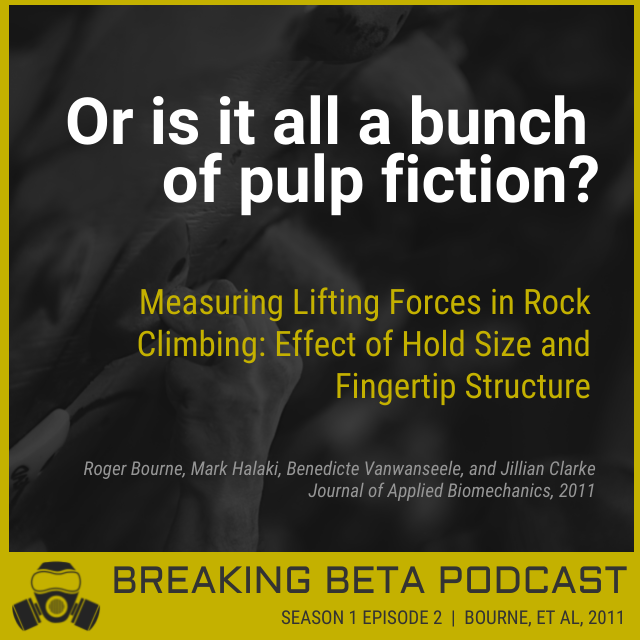
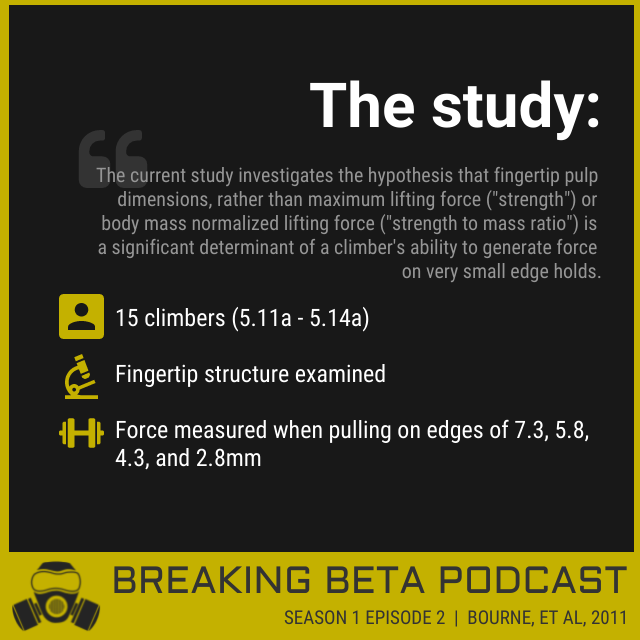
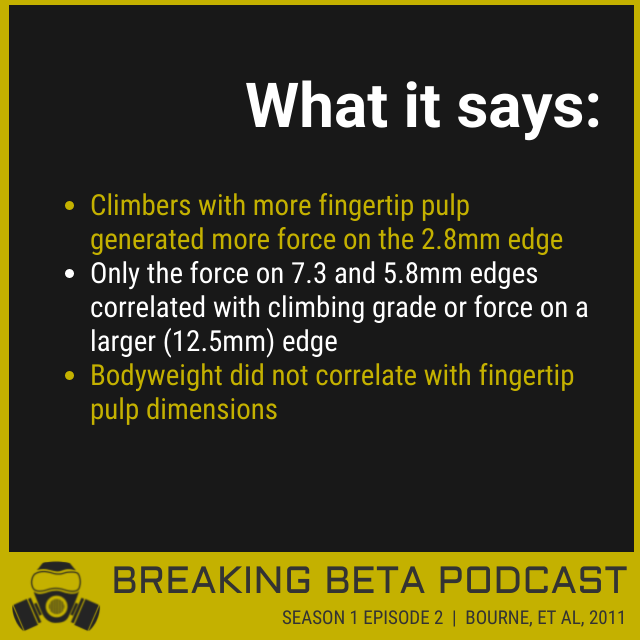
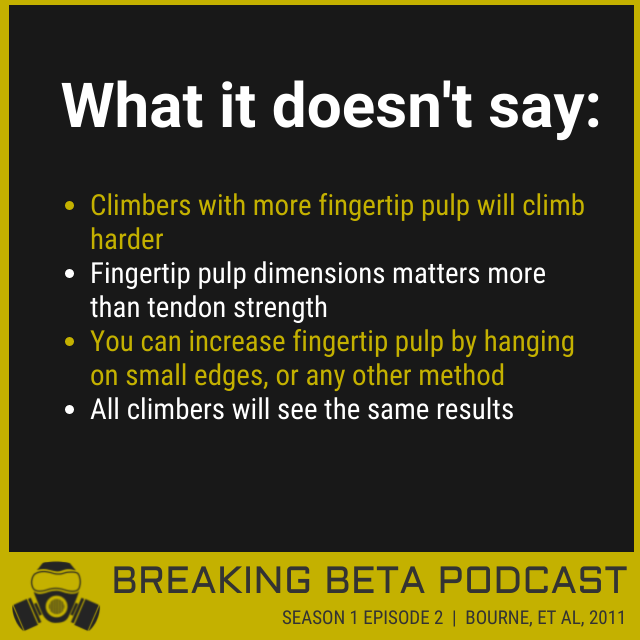

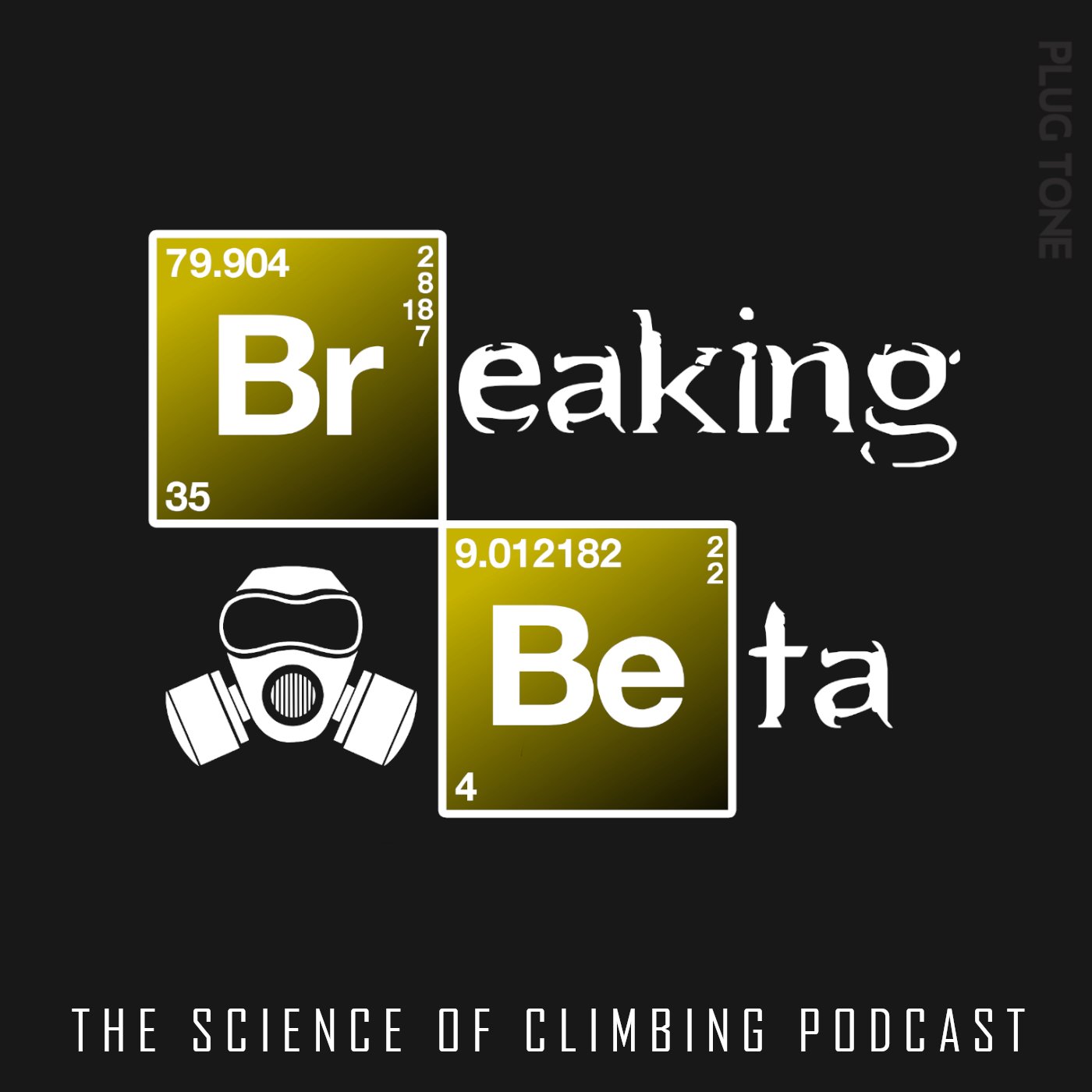
In this episode, Kris and Paul discuss the study that led to climbers everywhere both blaming and training their fingertip pulp:
Measuring Lifting Forces in Rock Climbing: Effect of Hold Size and Fingertip Structure
authored by Roger Bourne, Mark Halaki, Benedicte Vanwanseele, and Jillian Clarke; published in the Journal of Applied Biomechanics in 2011.
They’ll attempt to determine if just how meaty your tips are can actually help or hurt your climbing. And if so, is there even anything you can really do about it? Tune in to find out if it really does boil down to just the tips.
*Additional studies/resources mentioned in this episode:
Force response of the fingertip pulp to repeated compression—Effects of loading rate, loading angle and anthropometry authored by Elaine R.Serina, C.D. Mote Jr., and David Rempel; published in the Journal of Biomechanics, 1997.
New episodes of Breaking Beta drop on Wednesdays. Make sure you’re subscribed, leave us a review, and share!
And please tell all of your friends who are constantly telling you that you're only good at crimping because of your tiny fingers, that you have the perfect podcast for them.
Got a question? Comments? Want to suggest a paper to be discussed? Get in touch and let us know!
Breaking Beta is brought to you by Power Company Climbing and Crux Conditioning, and is a proud member of the Plug Tone Audio Collective. Find full episode transcripts, citations, and more at our website.
FULL EPISODE TRANSCRIPT:
Breaking Bad Audio Clip 00:05
How long is it gonna take you to get him what he needs?
I don't know. I have no idea. Several hours at least.
I can wait.
I guess it's time to talk about the state of this lab. Don't you have standards? I mean, this place is disgusting. We're going to scour every vat, every tank, every cook surface, and then we're going to clean up every possible source of contamination, and only then we cook.
Kris Hampton 00:32
The the reason for that clip may or may not become clear throughout the discussion of this paper, at least in my opinion of this paper. We're going to be talking today about.... I don't even know.... I don't know where this paper came from, necessarily. I know that sounds horrible. We're talking about finger pulp here. When when I first heard about this paper, this was like a new idea and the internet forums were flooded with people blaming their fingertip pulp, training their fingertip pulp, both of which I thought were dubious responses. We'll get to that later, though. Did you see this paper when it first came out or did you hear about it?
Paul Corsaro 01:27
I had heard about it. And when we were gathering papers for the season, to be completely honest, is the first time I've ever read the paper.
Kris Hampton 01:33
Got it.
Paul Corsaro 01:34
Yeah.
Kris Hampton 01:34
And the title of this paper is "Measuring Lifting Forces in Rock Climbing: The Effect of Hold Size and Fingertip Structure". Authors were Roger Bourne et al. The purpose of the paper, I've got it here, straight from the paper, "The current study investigates the hypothesis that fingertip pulp dimensions rather than maximum lifting force, strength, or body mass normalized lifting. Strength to mass ratio is a significant determinant of a climber's ability to generate force on very small edge holds." So I think this one kind of pairs well with what we did last week. And I think it's interesting that the, the original hypothesis from the authors was that fleshier fingers, big fat fingers, so to speak, would deform and roll off of edges, while bonier fingers would add stability. And I think that might have been everybody's hypothesis back then. You agree?
Paul Corsaro 02:48
Yeah, I think so. I thought it was interesting, where they talked about fleshy finger tip as might be typical of a heavy climber, and then a small bony finger, which might be typical of a small light climber. I thought that was a pretty wide generalization to make there.
Kris Hampton 03:04
Yeah, I kind of do too, especially after looking at a bunch of other papers, who say that fingertip shape and structure really had nothing to do with weight. I definitely thought they overreached a little when they said heavier climbers, lighter climbers have these types of fingers. But yeah, you know, this was a while ago, and we're all we're all learning, I think.
Paul Corsaro 03:29
This is actually earlier than last week's paper, which we, you know, we're talking about how that was one of the first ones we saw kind of going around so this has been... this is an older one for sure.
Kris Hampton 03:39
Yeah, totally. Let's jump into this thing.
Breaking Bad Audio Clip 03:44
You clearly, don't know who you're talking to, so let me clue you in.
Paul Corsaro 03:48
I'm Paul Corsaro.
Kris Hampton 03:50
I'm Kris Hampton.
Breaking Bad Audio Clip 03:51
Lucky two guys, but just guys, okay?
Paul Corsaro 03:55
And you're listening to Breaking Beta,
Kris Hampton 03:58
Where we explore and explain the science of climbing
Breaking Bad Audio Clip 04:01
With our skills, you'll earn more than you ever would on your own.
Breaking Bad Audio Clip 04:06
We've got work to do. Are you ready?
Paul Corsaro 04:10
I'm ready, are you?
Kris Hampton 04:12
I was born ready Paul. I I love talking on a microphone. I think that's essentially what it comes down to. Let's um... in looking at this paper let's start with methods
Breaking Bad Audio Clip 04:28
In a scenario like this, I don't suppose it is bad form to just flip a coin.
Kris Hampton 04:36
Flip a coin. That's, that's what climbing is a lot of the time, so why not? Methods for this paper. First off, there were 15 experienced climbers, 11 male, 4 female, so not a bad ratio, with a recent mean project grade of Australian 26-27, which is 12c/d, or 7c in French grades. So pretty strong climbers, not the same level of climber as in the Eva Lopez study we looked at last week, but still relatively elite climbers.
Paul Corsaro 05:19
One thing I did want to make a note about this group of subjects, it seems like their range of ability level was way larger than the other one. And we had, if I did this right, yeah, we had climbers who climbed 11a all the way up to climbers who climbed 14a
Kris Hampton 05:32
Right
Paul Corsaro 05:32
So I think that might be sort of important as we move forward into this one.
Kris Hampton 05:37
Totally. I think, I think that's an important thing to look at, in all of the studies that we're going to look at. Just because the mean says one thing, that doesn't mean that's true for every climber in the study. So we did have some experienced climbers here, but also some climbers who weren't climbing at nearly the same level.
Paul Corsaro 05:58
Yeah. And so for the test, what they basically did it looked like was, they both looked at structural components of the finger using ultrasound, I believe. And then they also did just a, pretty much simply put, a pulling test. They built an apparatus where you were pulling on a sandstone edge. You were standing basically on a scale, a force plate it looks like, and just they found the force you generated pulling was however much body weight you could reduce on the scale, if I interpreted that correctly. Did you get any other takeaways from that?
Kris Hampton 06:32
No, I, that's exactly how I think tests went. The edge size, they were able to adjust, so they had four edge sizes that they were using: 7.3 millimeter, 5.8 millimeter, 4.3, and 2.8 millimeter
Breaking Bad Audio Clip 06:52
Two 35 M and M, two furnaces,
Breaking Bad Audio Clip 06:55
It's "mm", millimeter.
Kris Hampton 06:57
And they also measured before and after doing this like cycle of different edge sizes, on a 12.5 millimeter edge and that was as a baseline for strength. I think there were a couple interesting and smart things about this study. Number one, the sandstone edge was from a nearby quarry, around Sydney, I believe. So it's really similar to the sandstone that these climbers were already accustomed to climbing on, so they would know how to use that particular friction to their benefit, which....
Paul Corsaro 07:38
They were familiar with that.
Kris Hampton 07:40
Yeah. And that, you know, for me, that's a real world application. You know, I see people who climb on slippery granite or limestone, come to a sandstone area and not know how to use the friction very well, so they're, they're not able to get the most out of it. I appreciate that they, you know, had that little detail in here.
Paul Corsaro 08:02
I also thought something they did was smart which was they added woodblocks to where the person was standing, so that everyone's hand was the exact same level. I think they standardized where the wrist crease was for everybody, so that made things nice and repeatable and consistent all the way throughout.
Kris Hampton 08:17
Yeah, absolutely. We've we've all experienced, like getting on to a boulder, where it's either really low for us, and it makes it hard to pull on or really high for us and it makes it hard to pull on. So standardizing that, where the edge was in relation to your size was really smart.
Paul Corsaro 08:37
I did notice something. I wonder if you noticed it as well. Did you notice anything else, that I thought that was kind of odd, about how they pulled on the hold, how they had people set up for it?
Kris Hampton 08:48
I didn't notice anything necessarily super odd. I do have a note that it looks like the edge was pretty sharp. That was a little concerning. And they also, I believe it was this study, that they did not restrict whether they used a closed crimp or not.
Paul Corsaro 09:06
That's what I kind of highlighted because
Kris Hampton 09:09
Yeah,
Paul Corsaro 09:09
And it says right below it that no subject used the thumb as an additional finger on the hold. So I don't know if that means no one close crimped, or whether like, you know, sometimes you'll take a crimp and you'll put your thumb on the edge too.
Kris Hampton 09:22
Mm hmm.
Paul Corsaro 09:23
But I think if people did close the close the thumb over the top of the index finger, that could be a pretty significant change in force generation, if they didn't control for that, if some people did that, and some people didn't.
Kris Hampton 09:34
Yeah, I agree. And, you know, part of me is like, well, some people favor one grip over the other, so allowing them to pull as hard as they can, however they feel best is smart. But then the other part of me is like, well, maybe we should have controlled to see, you know, and make sure that people aren't getting some benefit out of that grip.
Paul Corsaro 09:58
I mean, you would skew results if you had to pull with your pinky on, so it kind of makes sense.
Kris Hampton 10:03
Totally. I would. In fact, if I had to use my pinky and a full crimp, I might as well be, you know, V0, 5.10 climber.
Paul Corsaro 10:14
Negative outlier.
Kris Hampton 10:15
I wouldn't even fit in this study. One other thing about the the testing apparatus I thought was smart is that they had a panel, sort of right behind the block that they were pulling on, so that they couldn't get their weight really far under the weight and make it feel better to them. I think that's super smart. Last year, a couple of years ago, I was in Canada, I interviewed Yves Gravelle for the podcast, for the Power Company Podcast, and he was showing me how he had flipped over the Beastmaker micro edges, and could hang on the slopey side of the edges. I stood under them and tried to imagine what that might feel like and I instinctively walked further under the board to make them actually feel like a hold, because because they did not feel like a grip that could be pulled on when I was standing directly beneath it. So super smart adjustment in this case. The other thing just to note is that when they use the ultrasound, they measured both palmar pulp and tip pulp. And I'll just describe those briefly because we may be mentioning that later on in this episode. The tip pulp of your finger is the distance from, if you take your finger, you've got a bone that extends into the tip of your finger, the distance from that bone to the tip, so kind of just below your nail, that is the tip pulp and the distance straight down to where you would be grabbing a crimp, where a crimp might hit you or an edge might hit you is the palmar pulp. So both directions, straight out and straight down from that fingertip bone is what those two different types of pulp are.
Paul Corsaro 12:18
Another thing with the ultrasound is they also, they took two climbers and did both the right and left arm. I think they did the dominant arm for most people, if I'm not mistaken. I could be wrong there. But yeah, dominant hand. But for the for two people, they looked at the top non dominant hand too, to just make sure there weren't any significant left/right differences in the pulp. I thought two out of, what was it, fourteen people, twelve people?
Kris Hampton 12:45
Fifteen.
Paul Corsaro 12:46
Two out of 15. I mean, maybe they could have done more there.
Kris Hampton 12:51
I don't think that tells us much. Yeah, they do make that statement a couple of times. But for me that that ends up just being meaningless if they're only testing a couple of people.
Paul Corsaro 13:03
I don't have a degree in statistics, so maybe I'm wrong, but that seems like a small percentage of..... if you're gonna do one, I think they could have done both just to really make that claim.
Kris Hampton 13:14
Yep, I totally agree. Anything else on the methods?
Paul Corsaro 13:18
No, I like that they randomized the edge order just to kind of make sure... just to control for things. That was cool. Um, yeah, that's really all I noticed. You kind of covered it and then I made the comment about the thumb use, but other than that, yeah, pretty well set up, I think.
Kris Hampton 13:35
All right. Let's take a break. And then we'll come back and talk about what the paper saw in the results.
Breaking Bad Audio Clip 13:43
Please. Alright, I really need a break here, okay.
Lana Stigura 13:49
You're listening to the super nerdy podcast, so I can only assume that you're interested in improving your climbing. Well, good news. You're in luck.
Breaking Bad Audio Clip 13:55
Yeah science!
Lana Stigura 13:56
We have training options for nearly every level climber in nearly every situation, from general prep to fully custom, from ebooks to weekly plans delivered via mobile app. Visit powercompanyclimbing.com/breakingbeta for more info and while you're there, check out Kettlebells For Climbers 2, now available as either an ebook or a Proven Plan, the follow up to our wildly popular Kettlebells For Climbers plan that started so many climbers down the path to being stronger, better prepared and more athletic.
Breaking Bad Audio Clip 14:23
Let's all get back to work for Christ's sake, okay!
Kris Hampton 14:27
Okay, we are back from our break and looking over our papers here. You ready to jump into the results and our sort of verdict on the paper?
Paul Corsaro 14:40
I'm ready. You?
Kris Hampton 14:42
Ready.
Paul Corsaro 14:44
We're not here to sit in judgment.
Paul Corsaro 14:47
Why not? The thing is, if you just do stuff and nothing happens, what's it all mean? Whatever you think is supposed to happen, I'm telling you the exact reverse opposite of that is gonna happen.
Kris Hampton 15:07
I know it says we're not supposed to sit in judgment, but I'm gonna be kind of sitting in judgment, a lot of the time through this next 15 or 20 minutes.
Paul Corsaro 15:16
I cannot wait.
Kris Hampton 15:18
Just just warning you. First first thing from this, they mention, you know, you mentioned earlier about the body weight comments in the paper and they find that body weight is correlated with the palmar pulp, but not the tip pulp of the fingers. I actually went and looked at a bunch of other studies that look at pulp in the fingers and most of the studies, the vast majority of the studies that I saw, couldn't find a correlation with body weight and pulp in the fingers at all. Maybe those studies weren't differentiating between tip pulp and palmar pulp. But pretty much every study says it's all over the place, when we're looking at finger tip shape, structure and volume of pulp has no bearing on age or body weight, really. So I think that for me, that just doesn't even factor in.
Paul Corsaro 16:26
And I think if you look at the r scores for that correlation, again, disclaimer, I don't have a degree in statistics, but a rudimentary understanding. An r score of like .54ish, I think is where they said body weight was correlated with palmar pulp. Yeah, that's a correlation, but it's not a huge correlation. You know, it's still pretty close to that medium. So it's there, but there's probably going to be some variation from person to person there, I would imagine.
Kris Hampton 16:52
Mm hmm.
Breaking Bad Audio Clip 16:53
We flipped a coin, okay.
Kris Hampton 16:56
Yeah, the one thing I thought was interesting that came from this is that they only found correlation with the 12.5 millimeter edge, so the edge they used kind of for, you know, getting a baseline strength level. The only two edges that they found a correlation with that edge, or the force on that edge was the 7.3 and the 5.8. And those edges also correlated with max climbing grade, so for me, basically, those were the two important edges of the study. It's not the edge most people focus on when they read this study, but for me, those were the two that were important.
Paul Corsaro 17:40
I think so too. And I think you're gonna find more, you know, if we talk about real world app, real world application, I think we're gonna find more small edges in that zone then the 4.3 to 2.8 millimeter.
Kris Hampton 17:51
Exactly.
Paul Corsaro 17:52
Those are heinously small edges.
Kris Hampton 17:54
Yeah, it's a good thing we aren't often pulling on 2.8 millimeter edges while climbing,
Paul Corsaro 18:00
I'd probably quit climbing.
Kris Hampton 18:02
Interesting, interesting note here, in the Eva Lopez study that we looked at last week, during their training, the smallest edge that was used by those climbers, and remember, they were experienced climbers at 8a or 13b and above, the smallest edge used during training was five millimeters. So it's not really surprising to me that the 5.8 was the smallest edge here that correlated with max climbing grade. So I think that's a good takeaway. They say in this and this is the place where most people really latch on to these results, is that climbers with larger bone to tip pulp generated higher forces on the 2.8 millimeter edge. So if you have more pulp in your finger, which is the opposite of what they thought they would find
Paul Corsaro 19:04
They thought it was the palmar pulp, correct?
Kris Hampton 19:06
Well, they thought that it was going to be a bonier
Paul Corsaro 19:10
Right
Kris Hampton 19:11
Finger was gonna be able to pull harder on these tiny tiny edges, 2.8 millimeter. But what they found is if they had more pulp, they could generate higher forces on that tiny edge.
Paul Corsaro 19:24
That's right.
Kris Hampton 19:25
And that's where most people latch on to this thing and you know why we saw so many people in forums being like, "Am I just genetically cursed? I can never pull on small edges. I don't have much pulp.", even though you can't look at your fingers or feel your fingers and measure the pulp. You have to do it via ultrasound. Lots of climbers were immediately blaming their their lack of ability on small edges on their fingertip pulp and lots of climbers were talking about, "I need to train my finger pulp. I need more finger pulp. I need to be able to pull on tinier edges." So I.......<sigh>.... not a fan.
Paul Corsaro 20:09
I mean, we both looked around too, like, is there really any evidence and someone please shoot us the resources if they're there, is there evidence that we can change our finger pulp too?
Kris Hampton 20:21
Yeah, I would, I would like to know this. I looked pretty extensively, actually gave myself a massive headache searching for this. And I found Mark Anderson made some reference to a paper he saw at a summit that he went to, or someone referenced a paper, he didn't see the paper, but he said someone referenced it in a presentation, that said hanging on tiny edges increases your finger pulp. There are lots of instances online of people making that claim. Eric Horst also mentions it in an article. I couldn't find a single piece of literature that spoke to that. It may be out there. Please let us know if it is. I talked to Volker Schoffl, the German doctor who's done lots of research into fingers, finger injuries. He told me the only paper he knows of that speaks to whether finger pulp can increase or not, was a study done on primates, not on humans. So certainly they were not having primates hang on tiny edges to see if it increased their finger pulp, but if it's out there, I would love to know.
Paul Corsaro 21:45
I thought something that was interesting when they're looking at just the super small edges, they talked about looking at pulp, but something they found that was kind of interesting and it seemed like it was kind of unexpected was that their subjects height was also strongly correlated with the force produced on the smallest, the 2.8 millimeter edge
Kris Hampton 22:03
Yeah, height and reach both.
Paul Corsaro 22:05
And those are I think if you look at all the statistical measures, those are the highest correlations in the whole study.
Kris Hampton 22:11
Yeah, and
Paul Corsaro 22:12
Or strongest. I'm sorry, strongest.
Kris Hampton 22:14
When I when I read that I immediately wondered if hair color also correlated to the edge size?
Breaking Bad Audio Clip 22:21
Yeah, science!
Kris Hampton 22:24
So I don't I don't know what that means. You know, they they do note in the paper that they would have expected that also to correlate at other edge sizes, but it did not. Only on the 2.8 millimeter edge.
Paul Corsaro 22:40
So that's just an interesting thing. I don't really know where to go with that. But that is interesting. Makes you ponder.
Kris Hampton 22:47
Yeah. And climbers have said for a long time, you know, since way before this study, that pulling hard on big edges doesn't necessarily transfer to pulling hard on small edges and this does support that. So I think that's a that's a big win, when you know, something we've been saying for a long time gets supported.
Breaking Bad Audio Clip 23:08
Boo yah! Woo! Haha!
Kris Hampton 23:13
Anything else you found? Anything surprising in the results or this paper that you saw?
Paul Corsaro 23:20
Not especially. The most surprising thing to me was just the correlation of the reach with the small edge
Kris Hampton 23:27
Mm hmm. I was a little surprised that they chose 12.5 millimeters as the strength testing edge.
Paul Corsaro 23:34
Yes. Okay. I do have a note of that in my questions at the end of the study. Yeah.
Kris Hampton 23:38
Yeah. Particularly with having climbers, you know, who are climbing at like the 5.11 level, we we've recently started testing on, and by recently, I mean, in the last year or so, on a 10 millimeter as well and we get a fair amount of people who can't hang on the 10 millimeter edge at all, who are who are climbing at that level and even a little higher. So that seems like a pretty small strength testing edge. I'm not sure it actually is showing strength.
Paul Corsaro 24:13
Right. And, you know, they could definitely generate force because they're standing and not hanging, but I did have that highlighted and for kind of the same reason you did, like that's...12.5 millimeters a pretty small edge.
Kris Hampton 24:24
Mm hmm. Yeah, I don't think it's a bad study. You know, I'm not gonna say it's a bad study. I just think that maybe it doesn't really matter, you know, unless we can change our pulp dimensions and that still remains unclear. If we can change our pulp dimensions, though, the advice is seems to still be the same, pull on tiny edges, which is really convenient, you know. You do the thing. You adapt to the thing. You get better at the thing. Great.
Paul Corsaro 25:00
Yep, I think, you know, as coaches, we look at a lot of these studies as just use useful things to help us make decisions. And I think I read this study, maybe we have a better idea of some of the basic science behind how we move or how we use an edge, but it really doesn't help me make any coaching decision on what I'm gonna have someone do. So I think the setup's fairly good. I think it's, you know, a good controlled study, and I think they're getting meaningful results out of what they were looking for, or what they found, but it doesn't help me make programming or coaching decisions a whole lot.
Kris Hampton 25:37
Yep, I agree. Let's, even though we both may not have a whole lot, let's sort of jump into the application and see if there is anything maybe we can take away from this to help us improve as climbers.
Breaking Bad Audio Clip 25:53
All these little pieces, they are all part of the story, right? But they don't mean much on their own. But when you start telling me what you know, we start filling in the gaps. I'll have them in lockup before the sun goes down.
Kris Hampton 26:06
Alright, one thing I am taking away from this, and this is something I was already doing, it really just strengthens my resolve in this area, because there are tons of people talking about finger pulp farming, essentially, on the internets. Like I said before, the advice is to hang on small edges to increase that pulp, so particularly just prior to climbing outside, if that's something specific to the climbing you're doing, you should absolutely be hanging on those small edges. Pain tolerance, getting used to the edge size, and if it is helping you gain finger pulp, great. You'll be better at hanging on those 2.8 millimeter edges.
Paul Corsaro 26:58
Yep. I think also, if you're climbing on, you know, maybe super thin climbing or, you know, slabs or somewhere that you're using that, you know, 2.8, 4.3 millimeter edges, invest in one of those, you know, medieval stretching tables and get a little taller. I think that'll, that'll help too.
Kris Hampton 27:16
Hahahaha. Yeah, stretch your arms out.
Paul Corsaro 27:20
Yeah
Kris Hampton 27:20
Totally. Here's something interesting and maybe this isn't exactly application, but I, in my looking for finger pulp studies to see if we could increase our pulp, I came across a study where they were tapping the tips of their fingers on a plate and measuring the elasticity of the pulp. And what they found is that as you tap faster, the pulp stiffens as a response to that tapping. So I would be curious if loading really slow keeps the pulp elastic and if we were to look at a study where people were going fast, like dead pointing to a small edge, would you get the same results or does the pulp stiffen the same as in this other study?
Paul Corsaro 28:21
Interesting. Yeah. That would be something cool to look into.
Kris Hampton 28:23
In which case that would say, oh, you've got stiff pulp, you can't hang on the small edge anymore, so going slower and controlling the the movement might be better for grabbing small edges. Imagine that.
Paul Corsaro 28:36
Haha right. We've come back around.
Kris Hampton 28:38
Haha yeah.
Paul Corsaro 28:42
Yeah, that is interesting. Yeah, after, after we're done with this, you shoot me that paper. I want to read that.
Kris Hampton 28:47
Yeah, I'll see if I can pull it up again. And I'll have it you know, cited on the blog post for this episode, but just just interesting and me totally hypothesizing and wildly extrapolating as to what it might mean. There, there was something in this paper, and this is one of the places where I think science and the controlled nature of these studies can be.... maybe counterproductive isn't the right word, but it may be doesn't reflect reality all the time. They mentioned that or they suggest that the normal adaptive toughening of fingertip skin might be counterproductive to grabbing small edges and I think that's only the case if you have to grab the edge one time or a couple of times. But if you're grabbing it repeatedly trying to do a move, if you're slipping off of it repeatedly trying to do a move, if you're having to go to it fast and then adjust on it, you want thicker skin. Otherwise, you're not going to be able to try the damn move over and over. So for me that suggestion "Oh, maybe thinner skin is better", I, any climber who's climbed repeatedly on small edges will tell you otherwise.
Paul Corsaro 30:24
Yeah, I agree with you with that. That's yeah. Yeah, I agree.
Kris Hampton 30:30
They also, I'm going to go ahead and call this a flagrant foul. They say, and I'll just quote it here, "The perceived performance superiority of women when climbing on small edges may be the result of generally softer and thinner skin."
Paul Corsaro 30:48
Yikes.
Kris Hampton 30:49
Or, or maybe they're just strong and just bad asses. Maybe we don't have to just say, "Oh, it's because of their skin."
Paul Corsaro 31:00
Yeah.
Kris Hampton 31:01
You know. And like we said, this is an older study. We've all grown since then, so maybe I'll give them a pass on this one flagrant foul.
Paul Corsaro 31:13
Yeah.
Kris Hampton 31:15
Like you said, though, application, for me, doesn't change a whole lot.
Paul Corsaro 31:19
Yep. Yeah. Doesn't help me make decisions. But however, you know, the more we can add to our base of just basic science, to the sport of rock climbing, and to the unique things we do in rock climbing, I think the better. I think, still good that this was done. It adds to our base of knowledge or what's been done with climbing, testing and science. So I'm glad it was performed, it just doesn't help me make any decisions as a coach. It's a worthwhile study.
Kris Hampton 31:45
Yep, I agree. Good study. Well done. Results don't change anything for me. All right. You can find both Paul and I all over the internets by following the links right there in your show notes. You can find Paul at his gym Crux Conditioning in Chattanooga, Tennessee and if you're in that area, you should absolutely visit. If you have questions, comments, or papers you'd like for us to take a look at, hit us up at community.powercompanyclimbing.com/breakingbeta. Don't forget, subscribe to the show. Leave us a review. Please, please tell all of your friends who are constantly telling you that you're only good at crimping because of your tiny fingers, that you have the perfect podcast for them. And we will see you next week when we discuss stretching and power loss and whether the fact that you're flexible means that you're never going to be powerful.
Paul Corsaro 32:45
See you on the other side.
Breaking Bad Audio Clip 32:48
It's done.
Breaking Bad Audio Clip 32:49
You keep saying that and it's bullshit every time, always. You know what? I'm done.
Breaking Bad Audio Clip 32:56
Okay, you and I, we're done.
Kris Hampton 33:00
Breaking Bta is brought to you by Power Company Climbing, and Crux Conditioning, and as a proud member of the Plug Tone Audio Collective. For transcripts, citations and more, visit powercompanyclimbing.com/breakingbeta.
Breaking Bad Audio Clip 33:13
Let's not get lost in the who what and whens. The point is we did our due diligence.
Kris Hampton 33:20
Our music, including our theme song, "Tumbleweed", is from legendary South Dakota band Rifflord.
Breaking Bad Audio Clip 33:26
This is it. This is how it ends.




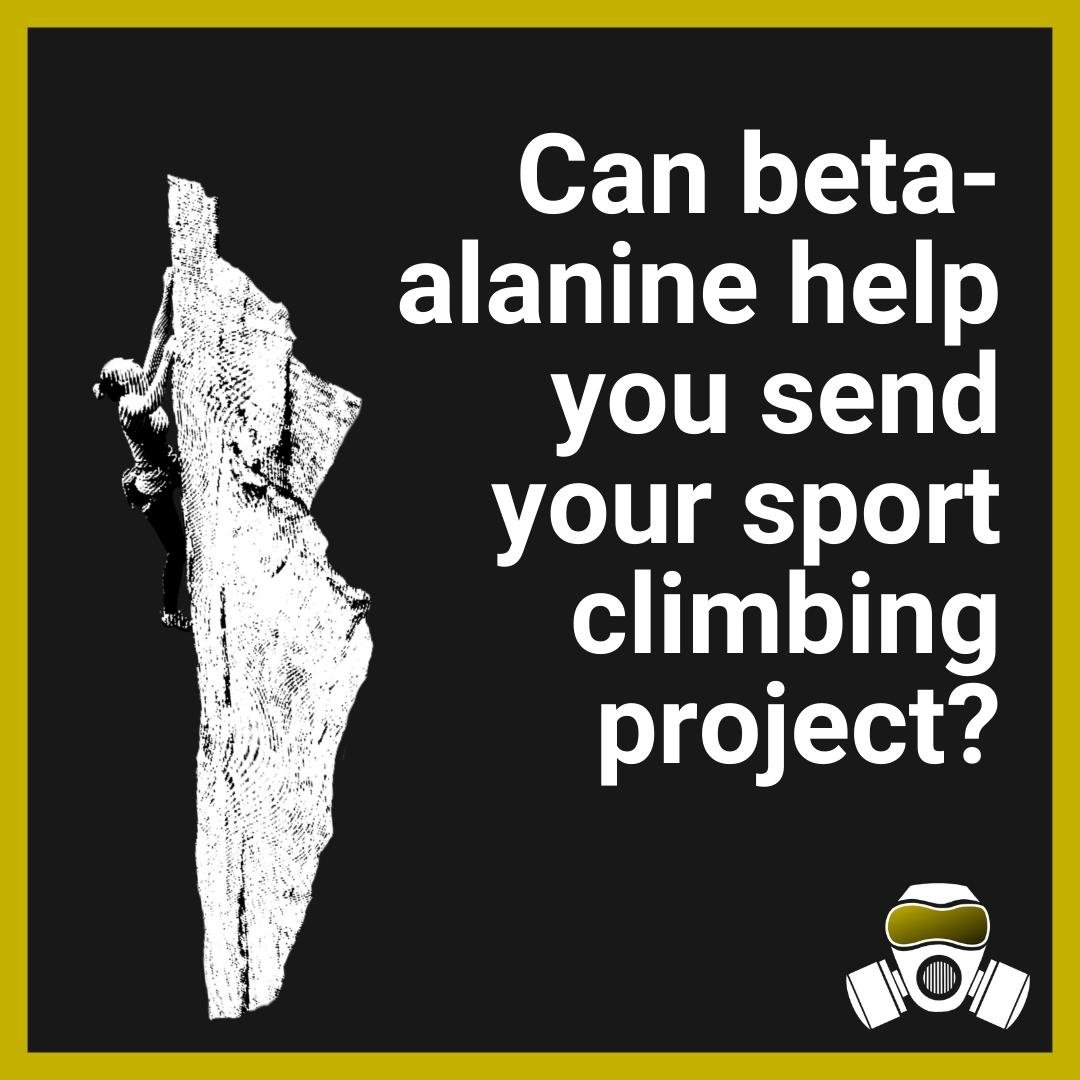

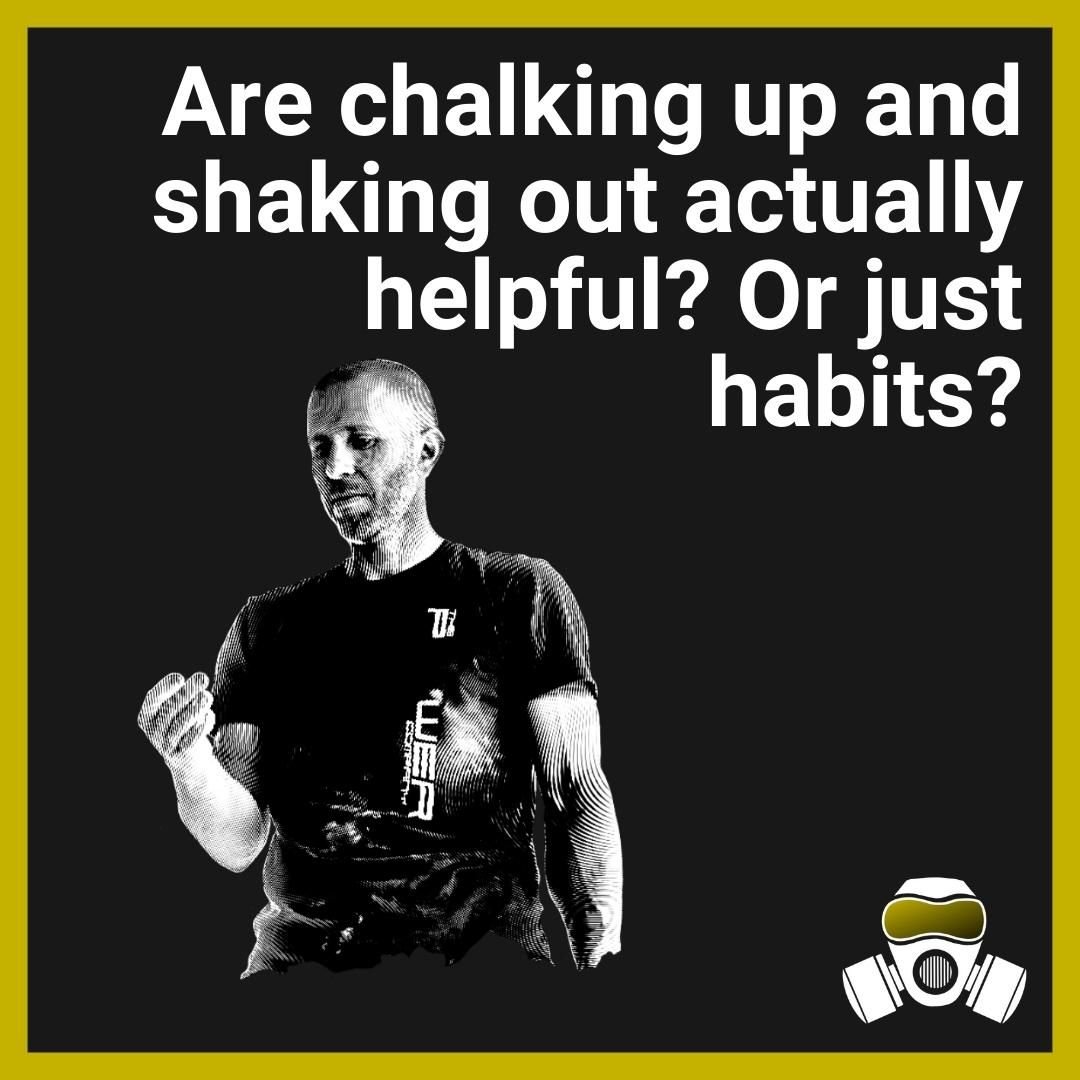
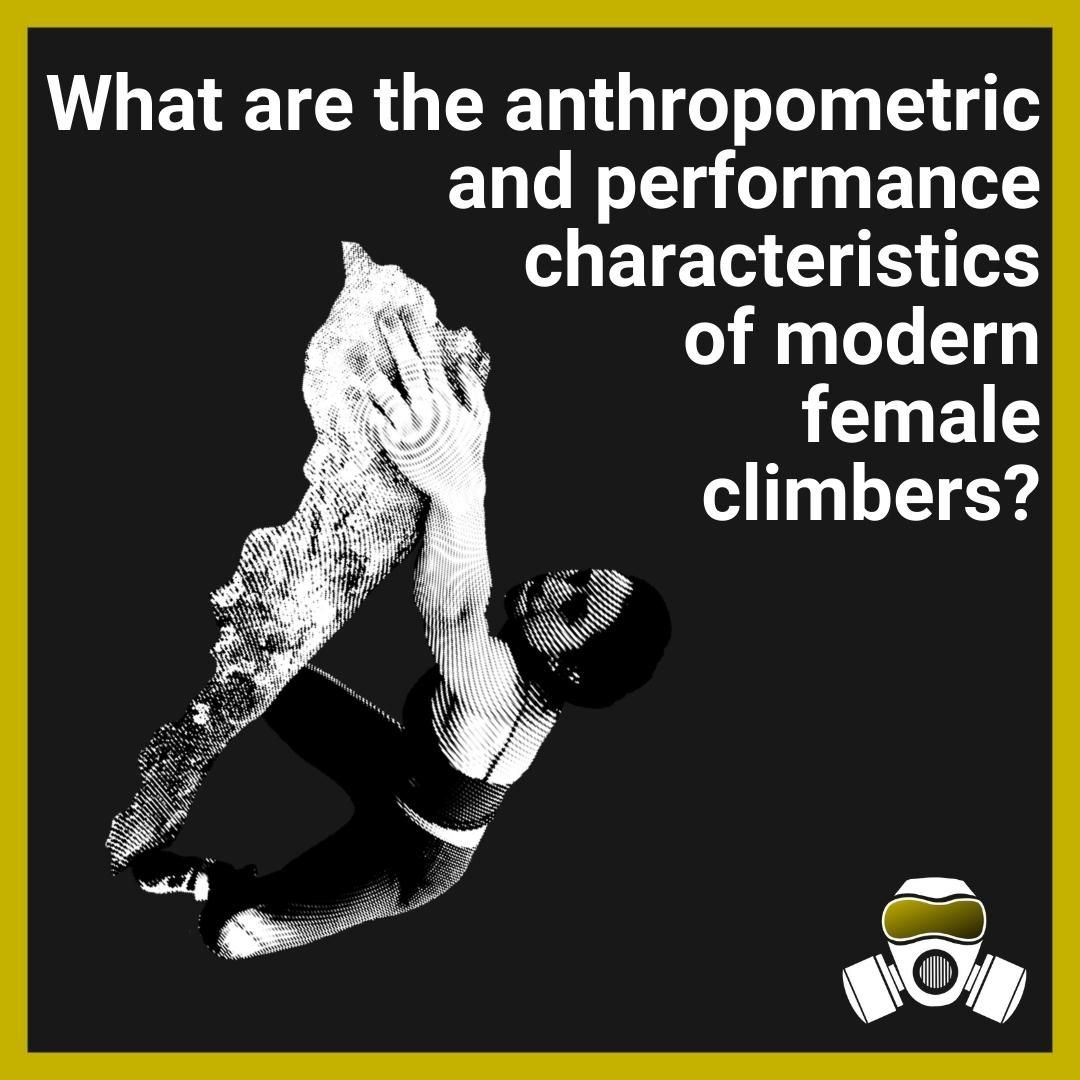


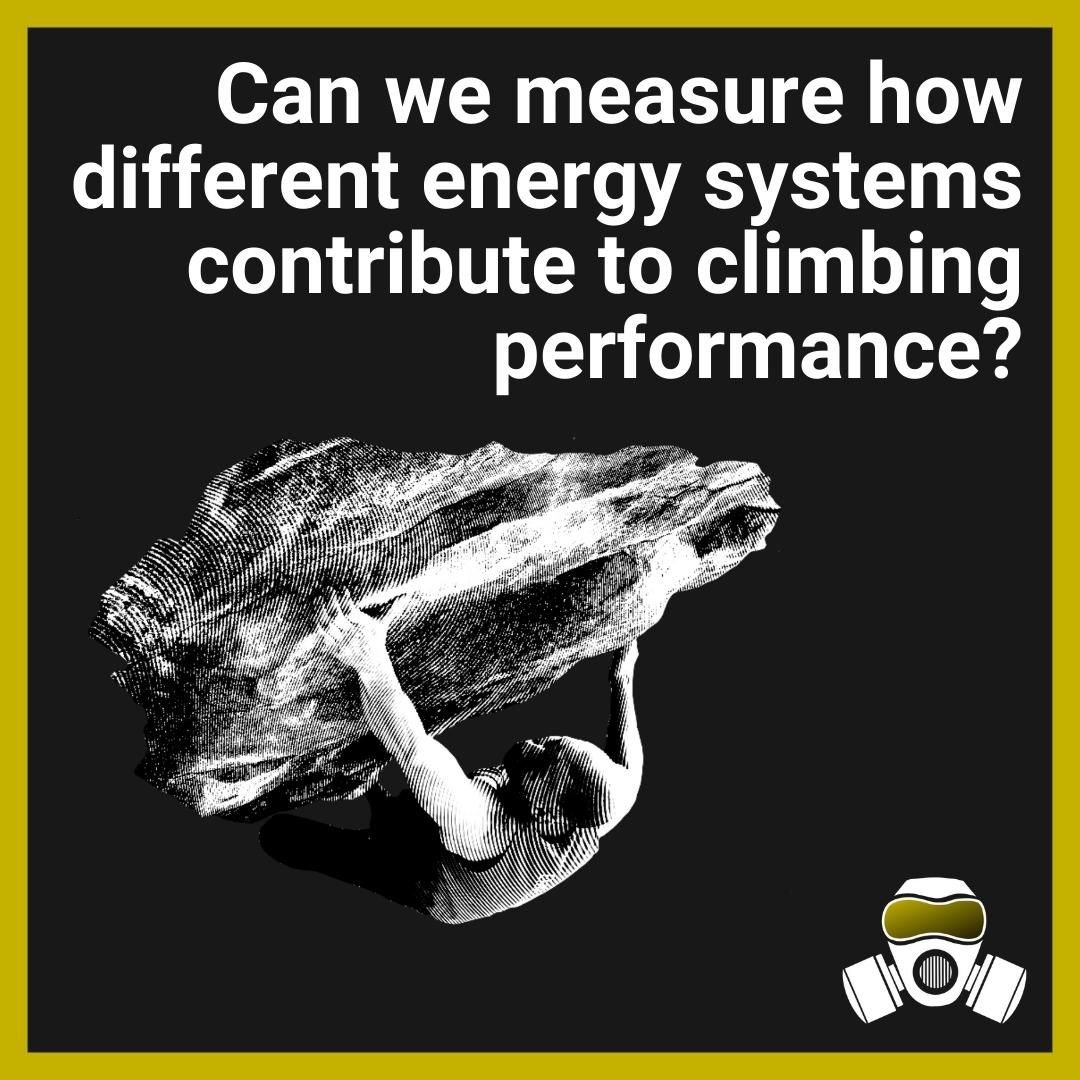
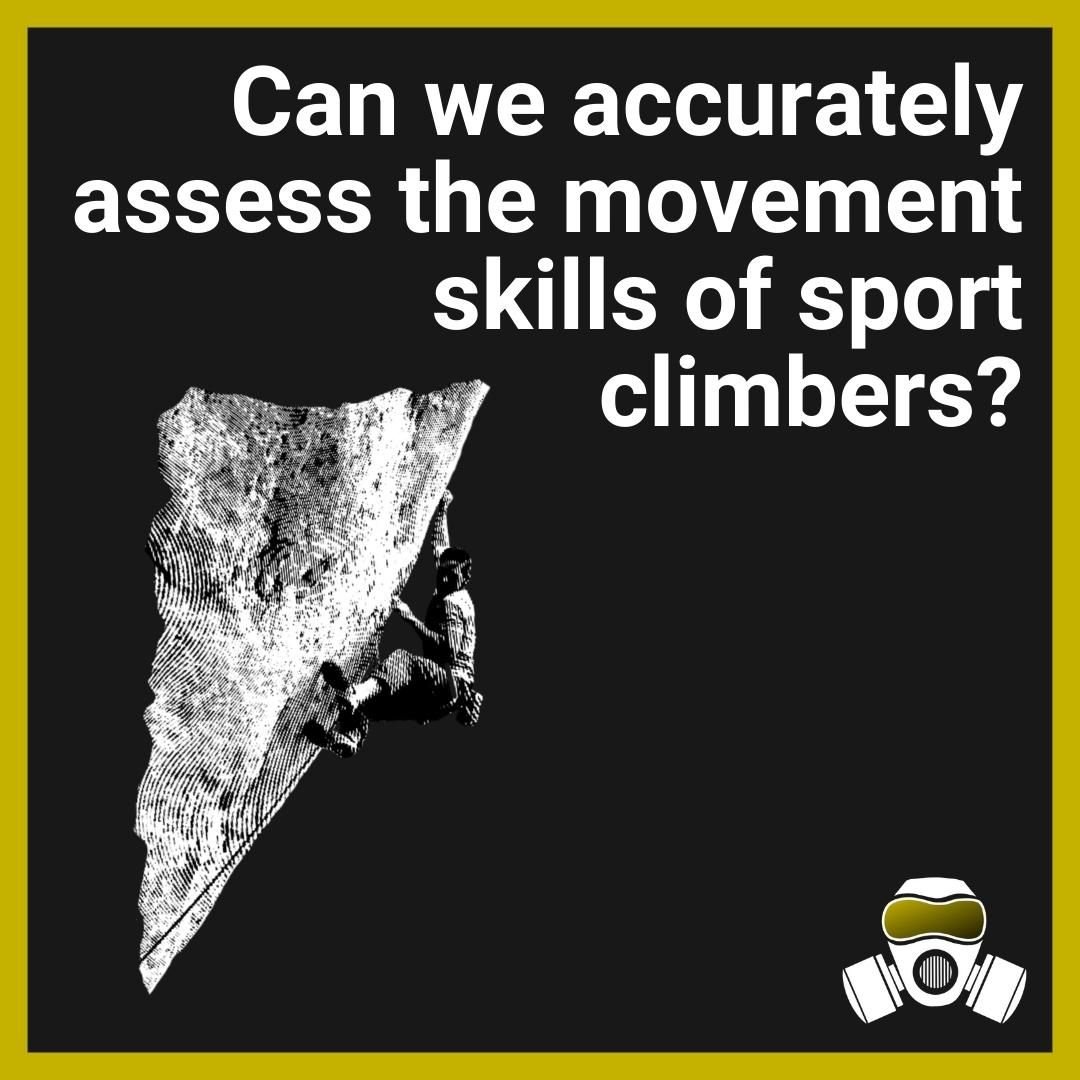
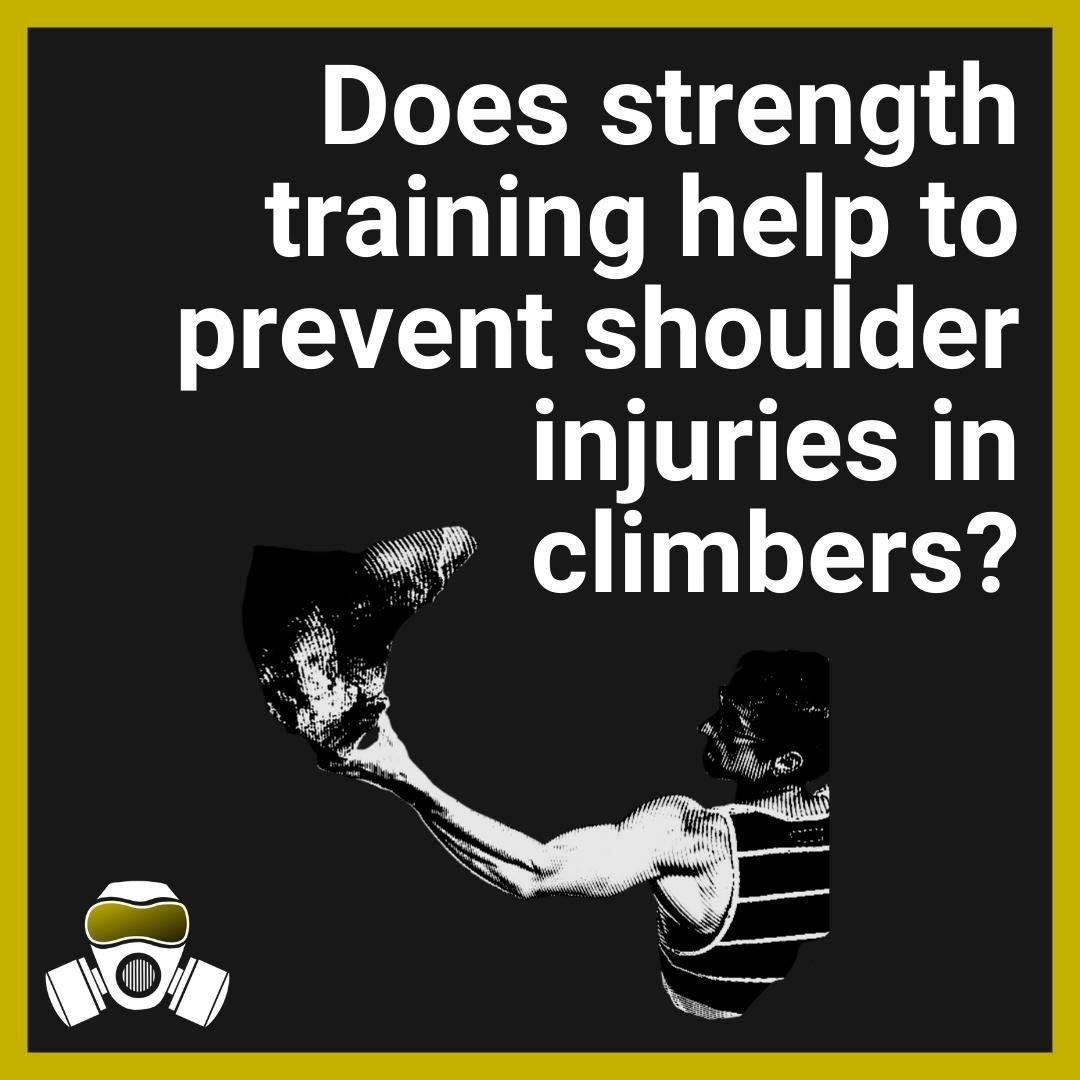







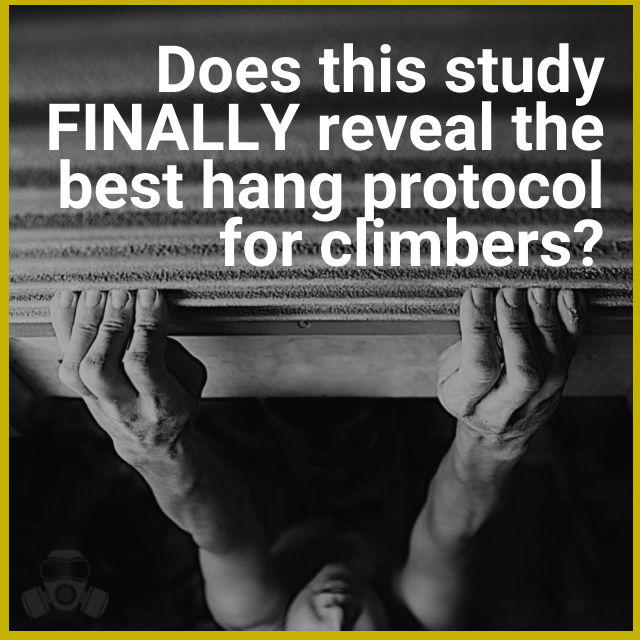

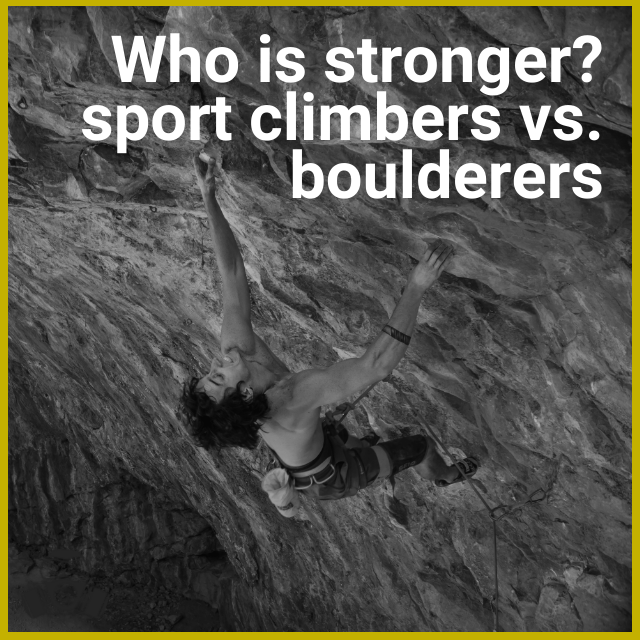

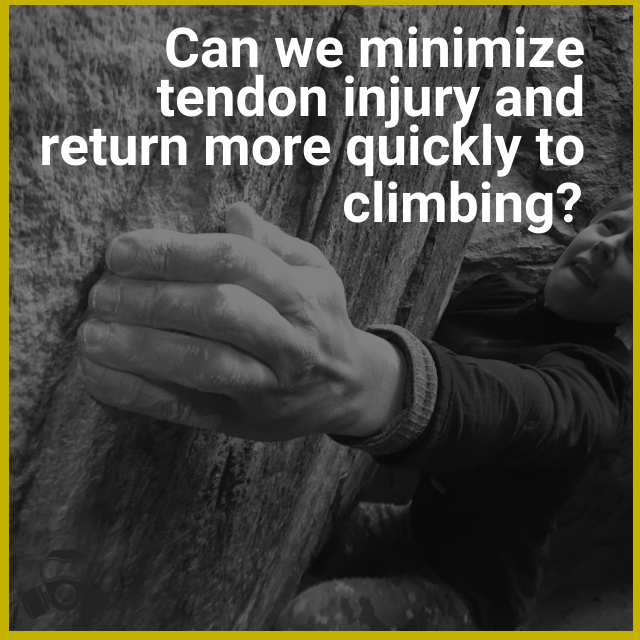
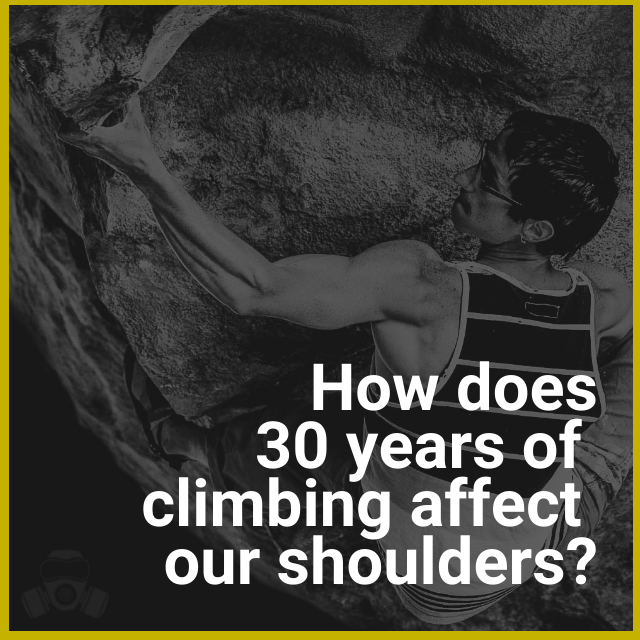

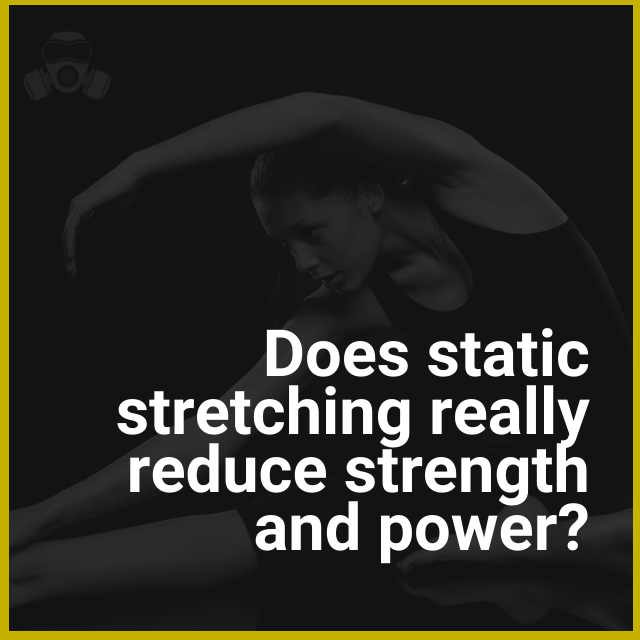


Explaining the science and calling out the misinterpretations.